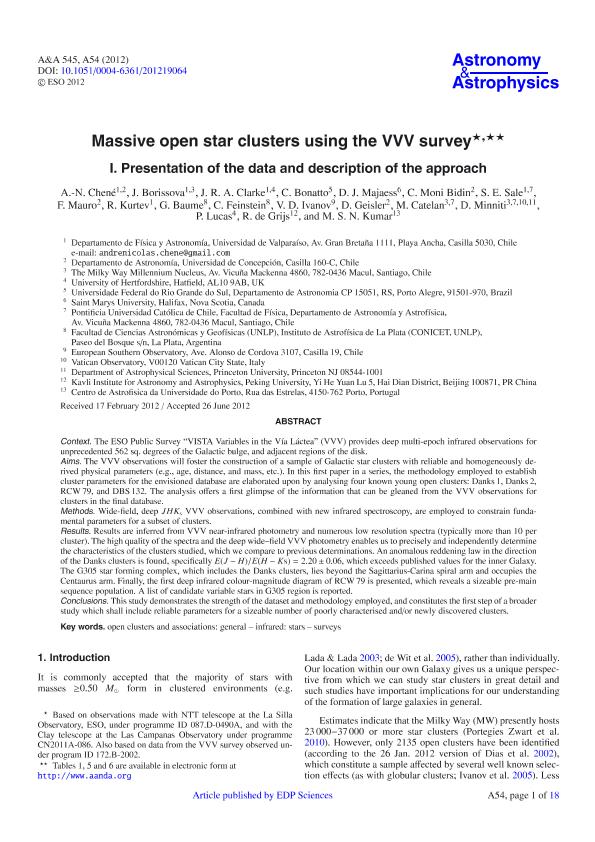Artículo
Massive open star clusters using the VVV survey, I: presentation of the data and description of the approach
Chené, A.-N.; Borissova, J.; Clarke, J. R. A.; Bonatto, C.; Majaess, D. J.; Moni Bidin, C.; Sale, S. E.; Mauro, F.; Kurtev, R.; Baume, Gustavo Luis ; Feinstein Baigorri, Carlos
; Feinstein Baigorri, Carlos ; Ivanov, V. D.; Geisler, Doug; Catelan, M.; Minniti, Dante; Lucas, P.; de Grijs, R.; Kumar, M. S. N.
; Ivanov, V. D.; Geisler, Doug; Catelan, M.; Minniti, Dante; Lucas, P.; de Grijs, R.; Kumar, M. S. N.
 ; Feinstein Baigorri, Carlos
; Feinstein Baigorri, Carlos ; Ivanov, V. D.; Geisler, Doug; Catelan, M.; Minniti, Dante; Lucas, P.; de Grijs, R.; Kumar, M. S. N.
; Ivanov, V. D.; Geisler, Doug; Catelan, M.; Minniti, Dante; Lucas, P.; de Grijs, R.; Kumar, M. S. N.
Fecha de publicación:
06/2012
Editorial:
EDP Sciences
Revista:
Astronomy and Astrophysics
ISSN:
0004-6361
Idioma:
Inglés
Tipo de recurso:
Artículo publicado
Clasificación temática:
Resumen
Context. The ESO Public Survey “VISTA Variables in the Vía Láctea” (VVV) provides deep multi-epoch infrared observations for unprecedented 562 sq. degrees of the Galactic bulge, and adjacent regions of the disk. Aims. The VVV observations will foster the construction of a sample of Galactic star clusters with reliable and homogeneously derived physical parameters (e.g., age, distance, and mass, etc.). In this first paper in a series, the methodology employed to establish cluster parameters for the envisioned database are elaborated upon by analysing four known young open clusters: Danks 1, Danks 2, RCW 79, and DBS 132. The analysis offers a first glimpse of the information that can be gleaned from the VVV observations for clusters in the final database. Methods. Wide-field, deep JHKs VVV observations, combined with new infrared spectroscopy, are employed to constrain fundamental parameters for a subset of clusters. Results. Results are inferred from VVV near-infrared photometry and numerous low resolution spectra (typically more than 10 per cluster). The high quality of the spectra and the deep wide–field VVV photometry enables us to precisely and independently determine the characteristics of the clusters studied, which we compare to previous determinations. An anomalous reddening law in the direction of the Danks clusters is found, specifically E(J − H)/E(H − Ks) = 2.20 ± 0.06, which exceeds published values for the inner Galaxy. The G305 star forming complex, which includes the Danks clusters, lies beyond the Sagittarius-Carina spiral arm and occupies the Centaurus arm. Finally, the first deep infrared colour-magnitude diagram of RCW 79 is presented, which reveals a sizeable pre-main sequence population. A list of candidate variable stars in G305 region is reported. Conclusions. This study demonstrates the strength of the dataset and methodology employed, and constitutes the first step of a broader study which shall include reliable parameters for a sizeable number of poorly characterised and/or newly discovered clusters.
Palabras clave:
Open Clusters
,
Infrared Stars
,
Surveys
,
Associations
Archivos asociados
Licencia
Identificadores
Colecciones
Articulos(IALP)
Articulos de INST.DE ASTROFISICA LA PLATA
Articulos de INST.DE ASTROFISICA LA PLATA
Citación
Chené, A.-N.; Borissova, J.; Clarke, J. R. A.; Bonatto, C.; Majaess, D. J.; et al.; Massive open star clusters using the VVV survey, I: presentation of the data and description of the approach; EDP Sciences; Astronomy and Astrophysics; 545; 54; 6-2012; 1-18
Compartir
Altmétricas



